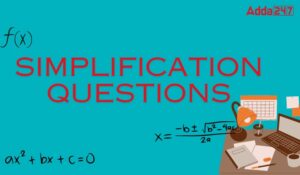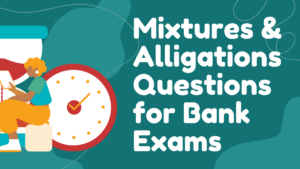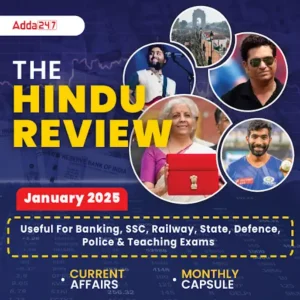Data sufficiency is a topic featured in the Reasoning Ability and Quantitative Aptitude sections of the Bank Mains exam and sometimes in the PO Prelims exam. These questions can be solved easily if the candidates thoroughly understand all the given conditions. Data Sufficiency questions have 2 or 3 statements for decision-making.
50+ Data Sufficiency Questions For Bank Exams
Here, we have provided 50 questions on Data Sufficiency from Reasoning Ability and Quantitative Aptitude as well.
Directions (1 – 3): Each of the given questions is followed by two statements I & II. You have to determine which statement (s) is/are sufficient/necessary to answer the question and mark answer accordingly.
Q1. Let x be total number of balls in a bag. Balls are of three different colors i.e. black, white and red. Calculate (x-1).
- Probability of getting a black ball is ⅙, a red ball is ⅙ & a white ball is ⅔.
- If one white ball is lost, probability of not getting a white ball is 8/23 and initial number of white balls in bag is less than 27.
(a) either statement I or II is sufficient
(b) both statements together are not sufficient to answer.
(c) both statements together are necessary to answer.
(d) only statement II is sufficient
(e) only statement I is sufficient
Q2. What is profit percent if an article is sold at marked price?
- on selling an article after giving 20% discount, profit earned is equal to loss incurred when same article is sold at 40% discount.
- after giving two successive discounts of 20% and 30% respectively, neither profit nor loss is incurred on an article.
(a) either statement I or II is sufficient
(b) both statements together are not sufficient to answer.
(c) both statements together are necessary to answer.
(d) only statement II is sufficient
(e) only statement I is sufficient
Q3. What is the length of platform?
- train ‘A’ can cross the platform in 20 sec and it can cross another train ‘B’ coming from opposite direction in 12 sec.
- train ‘B’ can cross the same platform in 15 sec and it can cross a man walking towards it in 4 sec.
(a) either statement I or II is sufficient
(b) only statement I is sufficient
(c) both statements together are necessary to answer.
(d) both statements together are not sufficient to answer.
(e) only statement II is sufficient
Directions (4-6): The following questions are accompanied by two statements I and II. You have to determine which statements(s) is/are sufficient/necessary to answer the questions.
Q4. Find difference between magnitude of twice of area and square of sum of length and breadth of the rectangle if its perimeter is equal to the perimeter of a square having area 3136 m2.
- Breadth of the rectangle is 25% less than the length of the rectangle.
- Side of the square is 8m more than 60% of the sum of the diagonals of the rectangle.
(a) Statement I alone is sufficient to answer the question but statement II alone is not sufficient to answer the questions.
(b) Statement II alone is sufficient to answer the question but statement I alone is not sufficient to answer the question.
(c) Both the statements taken together are necessary to answer the questions, but neither of the statements alone is sufficient to answer the question.
(d) Either statement I or statement II by itself is sufficient to answer the question.
(e) Statements I and II taken together are not sufficient to answer the question.
Q5. Find the two-digit number?
- Sum of the digits of the number is 25% of the number.
- Thrice of the number is 30 more than the number obtained on interchanging the digits.
(a) Statement I alone is sufficient to answer the question but statement II alone is not sufficient to answer the questions.
(b) Statement II alone is sufficient to answer the question but statement I alone is not sufficient to answer the question.
(c) Both the statements taken together are necessary to answer the questions, but neither of the statements alone is sufficient to answer the question.
(d) Either statement I or statement II by itself is sufficient to answer the question.
(e) Statements I and II taken together are not sufficient to answer the question.
Q6. What is the selling price of an article if the ratio of marked price to that of the cost price of the article is 8: 5?
- On article, first discount of 20% and then discount of 10% is given and difference between these discounts is Rs 192.
- Difference between marked price and the cost price of that article is Rs 600 and the profit percent earned on selling the article is 15.2%.
(a) Statement I alone is sufficient to answer the question but statement II alone is not sufficient to answer the questions.
(b) Statement II alone is sufficient to answer the question but statement I alone is not sufficient to answer the question.
(c) Both the statements taken together are necessary to answer the questions, but neither of the statements alone is sufficient to answer the question.
(d) Either statement I or statement II by itself is sufficient to answer the question.
(e) Statements I and II taken together are not sufficient to answer the question.
Q7. There is total 300 employees in ‘ADDA247’. Each of the employee like either coffee or tea or both. Find the number of employees who like either coffee or tea but not both.
Statement I – 55% employees like coffee.
Statement II – 70% employees like tea.
(a) Statement (I) alone is sufficient to answer the question but statement (II) alone is not sufficient to answer the questions.
(b) Statement (II) alone is sufficient to answer the question but statement (I) alone is not sufficient to answer the question.
(c) Both the statements taken together are necessary to answer the question, but neither of the statements alone is sufficient to answer the question.
(d) Either statement (I) or statement (II) by itself is sufficient to answer the question.
(e) Statements (I) and (II) taken together are not sufficient to answer the question.
Q8. Let ‘a’ be total number of balls in a bag. Balls are of three different colors i.e., black, white and red. Calculate ‘a’.
Statement I – Probability of getting a black ball is ⅙, a red ball is ⅙ & a white ball is ⅔.
Statement II – If one white ball is lost, probability of not getting a white ball is 8/23 and initial number of white balls in bag is less than 27.
(a) Statement (I) alone is sufficient to answer the question but statement (II) alone is not sufficient to answer the questions.
(b) Statement (II) alone is sufficient to answer the question but statement (I) alone is not sufficient to answer the question.
(c) Both the statements taken together are necessary to answer the questions, but neither of the statements alone is sufficient to answer the question.
(d) Either statement (I) or statement (II) by itself is sufficient to answer the question.
(e) Statements (I) and (II) taken together are not sufficient to answer the question.
Q9. What will be value of )?
Statement I – Reciprocal of x is more than that of y.
Statement II – Product of reciprocal of x & y is
(a) Statement I and II together sufficient
(b) Only Statement I sufficient alone
(c) Any two of them
(d) None of given Statement is sufficient
(e) None of these
Q10. What will be lateral surface area of cone?
Statement I – Height of cone is 12 cm.
Statement II – Radius of smaller sphere is of that of larger sphere.
Statement III – Radius of cone is of radius of larger sphere and difference between volume of both spheres is cm3.
(a) Either I and II or II and III are sufficient to answer the question
(b) Either I and II or I and III are sufficient to answer the question
(c) Either I and III or II and III are sufficient to answer the question
(d) I, II and III together are sufficient to answer the question
(e) All of the statements together are not sufficient to answer the question.
Q11. Find the share of Satish in profit after one year among Satish, veer and Yogesh
- Investment of Veer, Satish and Yogesh is in the ratio 6: 8: 9 and share of Yogesh in profit is Rs.900
- Satish and Veer invested Rs.8000 and Rs.6000 for 9 months and one year respectively. Difference b/w profit earned by Satish and Veer is Zero.
- Satish, Veer and Yogesh invested for 9 months, 1 year and 8 months respectively and share of Veer in profit is 900.
(a) Either A and B or B and C
(b) Either A and B or A and C
(c) Any two of them
(d) Either B alone or A and C together
(e) Either A and C or B and C
Q12. What is the cost of flooring a rectangular hall if cost of flooring is Rs. 50 per sq m?
- A. The length and the breadth of the hall are in the ratio 3: 2.
- B. Difference between length and breadth of the hall is 16 m.
- C. The perimeter of the hall is 160 m.
(a) Only A and B
(b) Only B and C
(c) Only A and C
(d) Any two of the three
(e) None of these
Q13. A train crosses another train in 10 sec. Find out difference between the lengths of the trains.
- Ratio between the lengths the of second and first train is 4: 5.
- Ratio between the speed of first and second trains is 2: 3.
- The speed of first train is 36 km/hr.
(a) Only A and B together
(b) All the three statements are required
(c) Only A and C together
(d) Questions can’t be answered even after using all the information
(e) None of these
Q14. Find the area of a rhombus.
- The ratio of the diagonals of the rhombus is 3: 4.
- The perimeter of the rhombus is equal to that of a square whose diagonal length is 40 m.
- The difference between the squares of the diagonals is 448 m2.
(a) All statements are required
(b) Any two of the given statements
(c) Only A and C
(d) Only B and C
(e) None of these
Q15. How many marks did Sumit obtain in Maths?
- The average marks obtained by Sumit in History, English and Maths is 70.
- The difference between the marks obtained by Sumit in English and that in History is 10.
- The total marks obtained by Sumit in Biology and Maths is 120.
(a) None of these
(b) Both A and B
(c) All of these
(d) Any two of them
(e) Question can’t be answered even after using all the information
Q16. Find the two-digit number.
- A. Sum of the squares of the two digits of the two digits number is 26.
- B. The ratio between the two-digit number and the sum of the digits of that number is 5:2.
- C. The digit in ten’s place is 4 less than the digit in unit place.
(a) Any one of them
(b) Only A and B together are sufficient
(c) Either A and C together or B alone
(d) Only B and C together are s
(e) None of these
Q17. Scheme A offers R% p.a. rate of interest on compound annually. Find the value of R.
Statement I – If interest received on Rs. on simple interest for 11 years at the rate of p.a. is half of when Rs. P invested in scheme A for 2 years.
Statement II – Rs. X is invested in scheme A for two years and it amounted Rs. 3600. If Rs. is invested at rate of (R – 10) % on CI annually for two years, then it amounted Rs. 1936.
Statement III- When Rs. Q invested in scheme A for two years and three years, then difference between interests is Rs. 1152.
(a) Statement (I) alone is sufficient answer the question
(b) Statement (II) alone is sufficient to answer the question
(c) All the three statements taken together are necessary to answer the question
(d) Either statement (I) alone or statement (II) and (III) together sufficient to answer the question.
(e) Either statement (I) alone or statement (II) alone is sufficient to answer the question.
Q18. Shopkeeper marked up a pen at certain percentage above its cost price. If marked price of pen is Rs. Y, then find the value of Y?
Statement I – Y is marked up 80% above cost price.
Statement II – Cost price of the pen is Rs. X. If shopkeeper allows a discount of 4% on marked price, then he makes a profit of 8% on it. When shopkeeper sells the pen at marked price, then he makes a profit of Rs. 28.
Statement III – Cost price of the pen is Rs. P. If shopkeeper allows a discount of 22 on marked price, then he makes a profit of Rs. 70.
(a) Statement (I) alone is sufficient answer the question
(b) Statement (II) alone is sufficient to answer the question
(c) All the three statements taken together are necessary to answer the question
(d) Either statement (II) alone or statement (I) and (III) together sufficient to answer the question.
(e) Statement (III) alone is sufficient to answer the question
Q19. What will be the probability of choosing two fresh eggs simultaneously from tray A given that there are only two trays i.e. tray A and tray B?
Statement I : Tray B contains 30 Eggs in which fresh and rotten eggs in the ratio 7 : 3. Ratio of fresh eggs in Tray A and Tray B is 2 : 3
Statement II : Tray A contains 20 Eggs in total out of which 14 are fresh and rest are rotten.
Statement III: Tray B contains 30 Eggs and Tray A contains 20 Eggs respectively. Ratio of Rotten eggs and fresh eggs in Tray A is 3:7
(a) Either I or II
(b) Either II or III
(c) Any one of them
(d) I alone
(e) All statements are required
Q20. Read the given information carefully and answer.
Statement I:
Statement II: 2, 19 and 7 are the only prime factors of 408842.
Statement III: Ram could not have an average speed of 2a km/hr for the whole journey if he travels 50% of that distance at an average speed of a km/hr.
(a) Both statements I & II are correct
(b) Both statements II & III are correct
(c) All statements are correct
(d) Both statements III & I are correct
Direction (21-23): The following questions are accompanied by two statements i.e. statement (I) and statement (II). You have to determine which statement (s) is/are sufficient/necessary to answer the questions.
(a) Neither statement (I) nor statement (II) by itself is sufficient to answer the question.
(b) Statement (II) alone is sufficient to answer the question but statement (I) alone is not sufficient to answer the question.
(c) Either statement (I) or statement (II) by itself is sufficient to answer the question.
(d) Both the statements taken together are necessary to answer the questions, but neither of the statements alone is sufficient to answer the question.
(e) Statement (I) alone is sufficient to answer the question but statement (II) alone is not sufficient to answer the questions.
Q21. Vessel A contains the mixture of milk and water. Find the quantity of milk in the initial solution.
Statement (I): When we extract 25 liters of mixture from the vessel for three times then the vessel gets empty.
Statement (II): When 15 liters of mixture is replaced by pure milk for the two times, then the ratio of milk to water in the final mixture becomes 17: 8
Q22. The marked price of articles P is the marked price of Q. Article P is mark up by above its cost price and allowed 50% of a discount on article Q. What is the cost price of P (in Rs)?
Statement I: On article Q seller makes a profit of 20%.
Statement II: Difference between the cost price of P and selling price of Q is Rs. 200
Q23. Find the sum of the ages of P and D two years ago.
Statement (I): Present age of P is twice the present age of Q and the ratio of the present age of R and Q is 3: 1 respectively.
Statement (II): Ratio of the present ages of A to D is 3: 5 and the age of A and R is same.
Q24. Two statements have been given. Analyze the given statements and answer whether the data given in the statements are sufficient to answer the question or not.
A mixture contains milk and water in the ratio of 16: 9, then find the total quantity of water in the mixture initially.
Statement I: Difference between quantity of milk and water in the mixture becomes 8 liter when quantity of water becomes double of initial.
Statement II: When 4 liters of milk is added and 2 liters of water is removed, then the milk in mixture becomes double of water.
(a) Only statement I
(b) Only statement II
(c) Both I and II are together
(d) Either I or II
(e) Neither I nor II
Q25. P and Q are positive integers. Find which of the following statement/s is /are required to find the is an integer.
Statement I. PQ is a multiple of 20.
Statement II. Both P and Q are multiple of five.
(a) None
(b) Only I
(c) Either I or II
(d) Both I & II together
(e) Only II
Directions (26-30): Each of the following questions below consists of a question and two statements numbered I and II given below it. You have to decide whether the data provided in the statements are sufficient to answer the question. Read both the statements and give answer.
(a) If the data in both the statements I and II together are necessary to answer the question.
(b) If the data in statement II alone are sufficient to answer the question, while the data in statement I alone are not sufficient to answer the question.
(c) If the data in either in statement I alone or in statement II alone are sufficient to answer the question.
(d) If the data in both the statements I and II together are not sufficient to answer the question.
(e) If the data in statement I alone are sufficient to answer the question, while the data in statement II alone are not sufficient in answer the question.
Q26. Who amongst A, Q, R, S and T is the tallest?
I. S is not the tallest. R is taller than A.
II. T is not the tallest. A is taller than Q.
Q27. In which month of the year did Raman go for a football match?
I. Aman correctly remembers that Raman went for a football match in the first half of the year.
II. Aman’s brother correctly remembers that Raman went for a football match after 31st March but before 1st May.
Q28. On which day of the same week is Rudra’s exam scheduled, if it is given that Monday being the first day of the week?
I. Monika correctly remembers that Rudra’s exam is scheduled on a day after Tuesday, but before Thursday of the same week.
II. Monika’s brother correctly remembers that Rudra’s exam is scheduled on the third day of the week.
Q28. How much marks has Sujit scored in the test?
I. Sujit scored two-digit marks. His marks is less than or equal to 20.
II. Sujit scored more than 9 marks in the test.
Q29. In which direction is point E, with reference to point S?
I. Point D is to east of point E. Point E is to the south of point F.
II. Point F is to the north-west of point S. Point D is to the north of point S.
Directions (31-33): Each of the following questions below consists of a question and two statements numbered I and II given below it. You have to decide whether the data provided in the statements are sufficient to answer the question. Read both the statements and give answer.
(a) If the data in statement I alone are sufficient to answer the question, while the data in statement II alone are not sufficient to answer the question.
(b) If the data in both the statements I and II are together necessary to answer the question.
(c) If the data in either statement I alone or in statement II alone are sufficient to answer the question.
(d) If the data in both the statements I and II together are not sufficient to answer the question.
(e) If the data in statement II alone are sufficient to answer the question, while the data in statement I alone are not sufficient to answer the question.
Q31. Which of the following five countries A, C, E, G and J is the biggest?
I. A is smaller than C. J is not the smallest.
II. E is smaller than A. G is not the biggest.
Q32. In which direction is point K, with respect to point M?
I. Point J is south of point K. Point K is the west of point L.
II. Point L is the north to point M. Point J is the east of point M.
Q33. How many runs Umesh has scored in the cricket match?
I. Umesh scored two-digit runs. His runs were more than 55.
II. Umesh scored less than 59 runs, but runs were not an even number.
Directions (34-36): Each of the questions below consists of a question and two statements numbered as I and II given below it. You have to decide whether the data provided in the statements are sufficient to answer the question. Read both the statements and give answer.
(a) if the data in statement I alone are sufficient to answer the question, while the data in statement II alone are not sufficient to answer the question.
(b) if the data in statement II alone are sufficient to answer the question, while the data in statement I alone are not sufficient to answer the question.
(c) if the data either in statement I alone or in statement II alone are sufficient to answer the question.
(d) if the data in both statements I and II together are necessary to answer the question
(e) If the data in both the statements I and II together are not sufficient to answer the question.
Q34. How is A related to F?
I. A has two sons B and C. C is married to D and has only three sons E, F and G.
II. A is wife of B. B has two sons C and D. D is married to E. F is the son of E
Q35. What is the code for ‘worship’ in a certain code language?
I. In that code language ‘worship powerful goddesses’ is coded as ‘asd, qer, tui’ and ‘most powerful image’ is coded as ‘zxc, qer, fgh’
II. In that code language ‘goddesses are powerful’ is coded as ‘asd, qer,jkl’ and ‘most priests worship’ is coded as ‘zxc, tui, wyp’
Q36. What is the direction of R with respect to Q?
I. P is 5m north of Q. Q is 4m west of T. T is 4m north of R
II. P is 5m south of Q. Q is 3m west of T. T is 5m west of R.
Directions (37-39): Each of the questions given below consists of a question and two statements numbered as I and II given below it. You have to decide whether the data provided in the statement are sufficient to answer the question. Read both the statements and Give answer:
(a) If the data in statement I alone are sufficient to answer the question, while the data in statement II alone are not sufficient to answer the question.
(b) If the data in both statements I and II together are necessary to answer the question.
(c) If the data either in statement I alone or in statement II alone are sufficient to answer the question.
(d) If the data even in both statements I and II together are not sufficient to answer the question.
(e) if the data in statement II alone are sufficient to answer the question, while the data in statement I alone are not sufficient to answer the question.
Q37. Who among the following persons P, Q, R, S and T got the highest marks?
I. P got second highest marks. Q got more marks than R and T but didn’t get the highest marks.
II. Only two persons got more marks than P. Q got more marks than P but less marks than S.
Q38. How R is related to F?
I. P is paternal grandmother of R who is sister of Q.
II. K is wife of F, Q is son of K. F is only child of P.
Q39. Five persons A, B, C, D and E live in a building of five floors but not necessarily in the same order. Ground floor is numbered as 1, the floor just above it is numbered as 2 and so on till the top floor is numbered as 5. Who lives on the 4th floor?
I. B lives exactly between E and D. B lives immediately above C’s floor and immediately below A’s floor.
II. Two persons live between E and C who lives immediately above D. B lives below A’s floor.
Direction (40-42): Each of the questions below consists of a question and two statements numbered I and II given below it. You have to decide whether the data provided in the statements are sufficient to answer the question. Read both the statements and give answer
(a) if the data in statement I alone are sufficient to answer the question, while the data in statement II alone are not sufficient to answer the question.
(b) if the data in both statements I and II together are necessary to answer the question.
(c) if the data either in statement I alone or in statement II alone are sufficient to answer the question.
(d) if the data in both statements I and II together are not sufficient to answer the question.
(e) if the data in statement II alone are sufficient to answer the question, while the data in statement I alone are not sufficient to answer the question.
Q40. Statement: Seven boys R, A, S, J, P, Y, O are there in a classroom each of them got different marks but not necessarily in the same order. Who among the following got lowest score?
I. S got more marks than J but less than O. Y got more marks than R but does not get the highest marks.
II. J does not get the lowest marks. P got more marks than A who got more marks than O.
Q41. Statement: Five persons R, S, T, U, V lives in a five-story building such as ground floor is numbered as 1 and above it 2 and so on until the topmost floor is numbered as 5 but not necessarily in the same order. How many persons live between R and V?
I. Two persons live between R and T. Only one person lives between T and U. T does not live on the topmost floor.
II. T lives above R. One person lives between S and V. V live above U.
Q42. Statement: Six persons A, B, C, D, E, F are sitting in two parallel rows. A, B, C are sitting in row-1 facing north and D, E, F are sitting in row-2 facing south such that the persons sitting in row-1 faces the persons sitting in row-2. Who among the following sits immediate right of A?
I. No one sits on the right of F. One person sits between B and C.
II. No one sits on the left of E. A is an immediate neighbours of B. Neither A nor B faces E.
Directions (43-45): Each of the questions below consists of a question and two statements numbered I and II given below it. You have to decide whether the data provided in the statements are sufficient to answer the question. Read both the statements and give answer
(a) if the data in statement I alone are sufficient to answer the question, while the data in statement II alone are not sufficient to answer the question.
(b) if the data in both statements I and II together are necessary to answer the question.
(c) if the data either in statement I alone or in statement II alone are sufficient to answer the question.
(d) if the data in both statements I and II together are not sufficient to answer the question.
(e) if the data in statement II alone are sufficient to answer the question, while the data in statement I alone are not sufficient to answer the question.
Q43. There are six members P, Q, R, S, T, and U living in a family. How is T related to S?
I. S is son of R. P and U are child of Q. T is grandfather of P.
II. R is mother-in-law of Q, who is a female member. S has no brother.
Q44. What is the distance between point P and Q?
I. Point S is 4m away in east direction from point P. Point T is in 2m north of point S.
II. Point Q is in north-west of point T.
Q45. What will be the code of ‘Engineer’ in the certain code language?
I. ‘some smarts are wise’ is written as ‘HV3 HH5 ZV2 DV3’ in that code language.
II. ‘scientists are genius’ is written as ‘HH9 ZV2 TH5’ in that code language.
Direction (46-48): Each of the questions below consists of a question and two statements numbered I and II given below it. You have to decide whether the data provided in the statements are sufficient to answer the question. Read both the statements and give answer
(a) if the data in statement I alone are sufficient to answer the question, while the data in statement II alone are not sufficient to answer the question.
(b) if the data in both statements I and II together are not sufficient to answer the question.
(c) if the data either in statement I alone or in statement II alone are sufficient to answer the question.
(d) if the data in both statements I and II together are necessary to answer the question.
(e) if the data in statement II alone are sufficient to answer the question, while the data in statement I alone are not sufficient to answer the question.
Q46. Six persons A, B, C, D, E and F are sitting around a circular table facing the center but not necessarily in the same order. Who among the following sits second to the left of B?
I. E sits opposite to C. Only one person sit between E and D. B is an immediate neighbour of F.
II. C sits second to the left of A. B neither sits opposite to C nor A.
Q47. Seven students S, D, G, J, N, B and X got different marks in the exam but not necessarily in the same order. Who among the following got highest marks?
I. X got more marks than only two students. S got more marks than J but less than B. B did not get highest marks. Both G and D got less marks than J.
II. G got more marks than only D. S got less marks than only two persons. J got more marks than X but less than S.
Q48. In the given coding system ‘No one is good’ is coded as ‘gn mu sy fd’ and ‘Good is not enough’ is coded as “gn sy mo lt”. Which of the following statement among the given is required to code ‘No one enough’?
I. ‘Place is nice’ is coded as ‘la sa sy’.
II. ‘Enough will be sufficient’ is coded as ‘ht mo ga sx’
Directions (49-50): Each of the questions below consists of a question and two statements numbered I and II given below it. You have to decide whether the data provided in the statements are sufficient to answer the question. Read both the statements and give answer
(a) if the data in statement I alone are sufficient to answer the question, while the data in statement II alone are not sufficient to answer the question.
(b) if the data in statement II alone are sufficient to answer the question, while the data in statement I alone are not sufficient to answer the question.
(c) if the data either in statement I alone or in statement II alone are sufficient to answer the question.
(d) if the data in both statements I and II together are necessary to answer the question.
(e) if the data in both statements I and II together are not sufficient to answer the question.
Q49. What is the code for ‘banks’ in a certain code language?
I. In that code language, ‘merger for good banks’ is coded as ‘lm ca to ck’ and ‘banks are good too’ is coded as ‘zk tm ca to’
II. In that code language, ‘merger banks are new’ is coded as ‘ck yo ca tm’ and ‘banks are good for’ is coded as ‘lm to ca tm’
Q50. What is the direction of Z with respect to K?
I. M is 5km to the east of K. S is 3km to the east of P. P is 3km north of M. Z is 5km to the south of S.
II. L is 5km to the east of K. M is 4km to the south of L. Z is 2km to the west of N. N is 5km to the west of M.
Solutions:
S1. Ans.(d)
Sol.
From I
Probability of getting a black ball is = ⅙
Let there are ‘a’ black balls & ‘6a’ total balls
Similarly, red balls= ‘a’
Probability of getting a while ball = ⅔ = 4/6
There will be 4a white balls.
x = 6a
But it can’t be solved further.
From II
Probability of getting a white ball = 1 – 8/23 = 15/23
Let here 15 m white balls and 23 m total remaining balls after 1 white ball is lost
And 23m + 1 = x
15m + 1 is initial number of white balls
15 m is multiple of 15, it could be
15, 30, 45….
But it is given that initial number is less than 27. Therefore, initial number of balls is 15m + 1 = 16 balls, and now 15 balls are remaining. Hence 23 m = x – 1
Put m=1
x=24 balls
Hence it can be answered from (ii) alone.
S2. Ans(a)
Sol. let CP be Rs 100x & MP be Rs 100y
From I, ATQ, 80y – 100x = 100x – 60y
x : y = 7 : 10 or 7k : 10k
required profit % = 3k/7k × 100 = 42 6/7%
From II, 100x = 56y
x : y = 14 : 25 or 14k : 25k
required profit % = 11k/14k × 100 = 78 4/7%
clearly, either statement is sufficient to answer.
S3. Ans(d)
Sol. Let length of train ‘A’ and train ‘B’ be x meter and y meter respectively.
Let length of platform be z meter.
Speed of train ‘A’ and train ‘B’ be a m/s and b m/s respectively
From I,
(x+z)/a = 20
(x+z)/ (a+b) = 12
No value of z can be calculated
From II,
(y+z)/ b = 15
No value of z can be determined,
Also, speed of man is unknown
Clearly, both statements together are not sufficient to answer.
S4. Ans.(d)
Sol.
Side of the square= 56m
From I: Let the length of the rectangle be 4x m.
Then its breadth=3x m
Side of that square= {2(4x+3x)}/ 2 = 7x m
x=8 m
length of the rectangle= 32m
and breadth of the rectangle= 24m
now, we can calculate the required difference
From II: Sum of the lengths of diagonals of the rectangle = 48/60 × 100 = 80 m
Diagonals of the rectangle= 40m
now, we can calculate the required difference
Hence, the question can be answered by using either of the two statements.
S5. Ans.(c)
Sol.
Let the ten’s place and unit’s place digits of the number be x and y respectively.
And, the number= (10x + y)
From I:
x + y = 0.25 (10x + y)
⟹ y = 2x
From II: 3(10x + y) – (10y + x) = 30
⟹ 29x – 7y = 30
Hence, Both the statements together are sufficient to answer the question.
S6. Ans.(d)
Sol.
Let the marked price and cost price be Rs 80x and Rs 50x respectively
From I: Selling price= 80x × 4/5 × 9/10 = Rs. 57.6x
And 16x – 6.4x = 192
x=20
SP = Rs 1152
From II: MP-CP=Rs 600
80x-50x=600
Marked price= Rs 1600
And cost price= Rs 1000
Selling price= Rs 1152
Hence, either of the two statements is sufficient to answer the question
S7. Ans(c)
Sol.
Let number of employees who like only coffee be x
And, number of employees who like both coffee and tea be y
And, number of employees who like only tea be z
Given, (x + y + z) = 300 ——– (i)
From Statement I –
(x + y) = 55/100 × 300
(x + y) = 165
From equation (i)
165 + z = 300
z = 135
From Statement II –
(y + z) = 70 × 300/100 = 210
(y + z) = 210
From equation (i)
x + 210 = 300
x = 90
From I & II together –
x + z = 135 + 90 = 225
So, both the statements taken together are necessary to answer the questions.
S8`. Ans.(b)
Sol.
From I
Probability of getting a black ball is = ⅙
Let there are ‘x’ black balls & ‘6x’ total balls
Similarly, red balls= ‘x’
Probability of getting a while ball = ⅔ = 4/6
There will be 4x white balls.
a = 6x
But it can’t be solved further.
From II
Probability of getting a white ball = 1 – 8/23 = 15/23
Let here 15 m white balls and 23 m total remaining balls after 1 white ball is lost
And 23m + 1 = a
15m + 1 is initial number of white balls
15 m is multiple of 15, it could be
15, 30, 45….
But it is given that initial number is less than 27. Therefore, initial number of white balls is 15m + 1 = 16 balls, and now 15 balls are remaining. Hence 23 m = a – 1
Put m=1
a=24 balls
Hence it can be answered from (ii) alone.
9. Ans(b)
Sol. In (61/x ÷ 61/y) = (61/x-1/y)
Statement I – Given, reciprocal of x is 1/48 more than that of y
1/x – 1/y = 1/48
So, (61/x ÷ 61/y) = 61/48
Statement II – given, Product of reciprocal of x & y is 1/192
1/x × 1/y = 1/192
xy = 192
From Statement II, we can’t determine the value of (61/x ÷ 61/y).
So, Only Statement I alone sufficient to give answer of the question.
S10. Ans(d)
Sol.
From I – Cone height = 12 cm
From II –
Let radius of larger sphere be ‘3x’
So, radius of smaller sphere be ‘2x’
From III –
Radius of cone = 3x × 5/6 = 15x/6
And, difference between volume of both spheres is 13336/ 21 cm3
From II & III –
(27x3 – 8x3) =
x = 2cm
using I, II, III lateral surface area of cone can be determined
So, all given statements together are required to answer
S11. Ans.(e)
Sol.
Veer : Satish : Yogesh
From A and C) 6×12 : 8×9 : 9×8
72 : 72 : 72
1 : 1 : 1
Share of Veer = Share of Satish Rs 900
Satish : Veer
From (B and C) 8000×9 : 6000×12
1 : 1
Share of Veer share of Satish = Rs 900
Either A and C or B and C question can be solved.
S12. Ans.(d)
Sol. From A: l : b = 3 : 2
From B: length- breadth= 16 m
Cost of flooring = 50 per sq m
l = 48 m
b = 32 m
Area = 48 × 32 sq m
Required price = 48 × 32 × 50
From C: perimeter = 160 m
Length = 3 × 16 = 48 m
Breadth = 16 × 2 = 32 m
Required cost = Rs. 48 × 32 × 50
we can get the cost of flooring a rectangular hall using any of the two statements.
S13. Ans.(d)
Sol. From A: Let the length of second and first train be m respectively
From B: Let speed of first and second train be 2y m/s and 3y m/sec
From C: Speed of first train = 36 km/hr= 10 m/s
As we don’t know the directions of their motion so relative speed can’t be determined
S14. Ans.(b)
Sol.
From A: let the diagonals be 3x m and 4x m.
From B: Side of square= 40 m
Perimeter of rhombus= perimeter of the square= 160 m
From C:
x = 8, diagonal = 24, 32
Area =
So, using any two of the given three statements we can find area of the rhombus.
S15. Ans.(e)
Sol.
From A: History+ English +Maths=210
From B: Either History-English= 10 or English-History=10
From C: Biology+ Maths=120
So, marks of maths can’t be determined using the given information
S16. Ans.(c)
Sol. Let the required number be where x is the ten’s digit and y is the unit’s digit
From A:
From B:
From C:
S17. Ans(e)
Sol.
From I –
– 1]
So, From I we can get the value of R
From II –
And,
From equ. (i) and (ii), we can get the value of R.
From III – From III we can get two variables first Amount ‘Q’ and second Rate of interest ‘R’. So, we can’t determine the value of two variables from one equation.
So, either statement (I) or statement (II) alone is sufficient to answer the question
S18. Ans(d)
Sol.
Given, marked price of pen = Rs. Y
From I – We can’t know the cost price of pen. So, we can’t determine marked up how much percentage above its cost price.
From II – Give, Cost price of pen = Rs. x
So, selling price of pen = Rs. 1.08x
And given, shopkeeper allows a discount of 4% on marked price
So, 96% = Rs. 1.08x
100% (marked price) = 1.125x Rs.
ATQ –
1.125x – x = 28
x = 224
Marked price of pen (Y) = 1.125
So, from II we can determine the value of Y.
From III – Given, cost price = Rs. P
And, selling price of pen = Rs. (P + 70)
ATQ –
Marked price of pen =
From I & III –
P
12.6P – 9P = 630
3.6P = 630
P = 175
So, marked price of pen (Y) = Rs.
So, either statement (II) alone or statement (I) and (III) together sufficient to answer the question.
S19. Ans.(b)
Sol.
From Statement I,
Tray B = 30
Rotten eggs in Tray B = 9
Fresh eggs in Tray B = 21
Tray A,
Fresh eggs = 14
From Statement II,
Tray A = 20 eggs
Fresh eggs in Tray A = 14 Rotten eggs in Tray A = 6
From Statement III,
Tray B = 30 eggs
Tray A = 20 Eggs
Rotten eggs in Tray A =6
Fresh eggs in Tray A = 14
From Either II or III question can be solved.
S20. Ans. (e)
Sol.
From Statement I:
⇒ 8! ×
⇒ 8! ×
Here, is greater than 8!
So, Statement I is false
From Statement II:
On dividing 408842 by 2, 19 and 7 we get 1537 as answer.
Further 1537 is the product of 53 & 29.
So, Statement II is also false
From Statement III:
Let the total distance be 2x km and let the remaining distance he travelled at a speed of y km/hr.
ATQ,
⇒ (It is not possible)
So, Statements III is true.
S21. Ans. (d)
Sol.
From statement (I): As when we remove 25 liters of solution three times then vessel gets empty
So, Quantity of mixture = 25×3=75 liters
From (II)
We can’t find the milk in the initial mixture
From (I) and (II)
Quantity of water in the final mixture =
According to the formula
Let the quantity of water in the initial mixture be x liters
x =
x = 37.5
Quantity of milk in the initial mixture = 75-37.5 = 37.5 liters
S22. Ans. (b)
Sol.
Let the marked price of the Q be Rs 300x
Marked price of P =
Cost price of P =
Selling price of Q =
From (I): We don’t have any actual value so we can’t find anything from here.
From (II): 350x – 150x = 200
x = 1
Cost price of P = Rs. 350
S23. Ans. (a)
Sol.
From (I): From this statement we get the ages of P, Q and R in the ratio as we don’t have any actual value of any member
From (II): From this statement we get the ages of A and D in the ratio as we don’t have any actual value of any member
S24. Ans. (d)
Sol.
Statement I: let the quantity of water and milk be 9x and 16x respectively.
ATQ,
9x + 9x – 16x = 8
18x – 16x = 8
2x = 8
4 = x
Quantity of water = 36 liter
Statement II:
Quantity of water = 36 liters
S25. Ans (b)
Sol.
Statement I. PQ is a multiple of 20.
Then it is multiple of 10 and 5 both always so when we divide P×Q by 10 it always gives and integral value.
= and the resultant value always comes in integers.
Statement II. Let P be 5, 20, 10, 15
And Q be 15, 10, 5, 10
If P= 20 and Q = 10
2 is an integer
But if P = 15 and Q = 5
7.5 is not an integer
- (a): From I: R> A, but S is not the tallest.
From II: A> Q, but T is not the tallest.
From I and II: R > A > Q. Neither S nor T can be the tallest. Hence R is the tallest.
- (b): From I: Possible months: January, February, March, April, May or June.
From II: Aman’s brother correctly remembers that he went for a football match after 31st March but before 1st May.
So, he went for a football match in the month of April.
Hence only II is sufficient.
- (c): Rudra’s exam is on scheduled on Wednesday.
Hence, either statement I alone or statement II alone is sufficient.
- (d):
- (a): From I and II:
Point E is to the north-west of Point S.
Directions (31-33):
- (d): From I: C > A, but J is not the smallest.
From II: A > E, but G is not the biggest.
From I and II: C>A>E. And it is not clear J and G’s position so we cannot determine which is the biggest country.
- (d): From I:
From II:
So, From I and From II it is not clear point K’s direction with respect point M.
- (b): From both I and II: Possible runs: 56, 57, 58.
But runs were not an even number. So Umesh scored 57 runs
Direction (34-36):
- (b): I. From the given statement:
We cannot determine the relation of A with F.
- From the given statement:
Here, A is the grandmother of F.
- (d): The following are the codes for the words when we combine I and II
| Words | Codes |
| goddesses | asd |
| powerful | qer |
| Are | jkl |
| worship | tui |
| most | zxc |
| priests | wyp |
| image | fgh |
Hence, code for worship is ‘tui’
- (c): I. From the given statement:
Here, R is in south-east of Q.
- From the given statement:
Here, R is to the east of Q.
Directions (37-39):
- (c): From I, we can determine that S got the highest marks
From II, we can determine that S got the highest marks
- (b): On combining I and II we can determine, R is daughter of F
- (a): From, I we can determine, A lives on the 4th floor
| FLOOR | PERSON |
| 5 | E/D |
| 4 | A |
| 3 | B |
| 2 | C |
| 1 | E/D |
From, II we cannot determine , who lives on the 4th floor
Direction (40-42):
- (b): From I, Y>R and O>S>J
From II, P>A>O
From I and II, we get that R got the lowest marks.
- (d): From I and II,
| Floors | Persons |
| 5 | S/V |
| 4 | T |
| 3 | V/S |
| 2 | U |
| 1 | R |
- (b): From I and II,
Direction (43-45):
- (b): From both the statements I and II we can find that T is father of S.
- (d): By combining both the statements together we cannot find the distance between point P and Q.
- (c): From statement I or II-Engineer code will be VI7.
Direction (46-48):
- (d): From both I and II,
- (a): From I,
N > B > S > J > X > G/D > D/G
From II,
N/B > N/B > S > J > X > G > D
- (b):
Directions (49-50):
- (d): By combining both the statements I. and II. then we get “banks” is coded as “ca”
| Words | Codes |
| merger | ck |
| for | lm |
| good | to |
| banks | ca |
| are | tm |
| New | yo |
| too | zk |
- (c): I. M is 5km to the east of K. S is 3km to the east of P.P is 3km to the north of M. Z is 5km to the south of S. So, Z is south east of K.
II. L is 5km to the east of K.M is 4km to the south of L.Z is 2km to the west of N.N is 5km to the west of M. So, Z is south west of K.




 Simplification Questions For Bank Exams ...
Simplification Questions For Bank Exams ...
 Quantity Comparison Questions for Bank E...
Quantity Comparison Questions for Bank E...
 Mixture & Alligation Questions for B...
Mixture & Alligation Questions for B...





